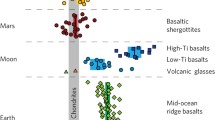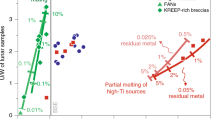Abstract—
The model of the formation of the Earth–Moon system during the compression and fragmentation of a gas–dust cloud (Galimov, 2011; Galimov and Krivtsov, 2012) suggests an unusual mechanism for the formation of the Earth’s core. In particular, the model predicts that iron in the Earth’s core should be enriched in the light isotope, and the Earth’s mantle should be, conversely, enriched in the heavy isotope compared to the primary iron (of chondrites). The alternative (megaimpact) model does not allow for this phenomenon. This problem could be solved by comparing the iron isotope composition of the Earth’s and Moon’s mantles. The best representation of the iron isotope composition of the lunar mantle (δ57Fe) is given by the Fe isotope composition of lunar basalts with very low titanium content (VLT), just as the best representation of the isotope composition of iron in the Earth’s mantle is given by the δ57Fe of the Earth’s mid-oceanic ridge basalts (MORB). VLT basalts are relatively scarce on the lunar surface, unlike high-titanium basalts, which fill lunar lowlands. Their iron isotope composition has not yet been measured. We were the first to analyze the iron isotope composition of very low-titanium lunar basalts (VLT) in material delivered by the Luna 24 space mission. Our data indicate that the δ57Fe of Earth’s mantle is higher than the δ57Fe of the bulk silicate Moon, which means (with a high degree of probability) that the Earth’s core is enriched in the light iron isotope. This, in turn, is in good agreement with the model of formation of the Earth–Moon system by the compression and fragmentation of the gas–dust cloud.


Similar content being viewed by others
REFERENCES
V. L. Barsukov, “Preliminary data for the regolith core brought to the Earth by the automatic lunar station Luna 24,” 8th Lunar and Planetary Science Conference, 3303–3318 (1977).
R. M. Canap, “Forming a Moon with an Earth–like composition via a giant impact,” Science 338, 1052–1055 (2006).
R. M. Canap and E. Asphaug, “Origin of the Moon in a Giant impact near the end of the Earth’s formation,” Nature 41 (6848), 708–712 (2001).
P. R. Craddock and N. Dauphas, “Iron isotopic compositions of geological reference materials and chondrites,” Geostand. Geoanalytical Res. 35, 101–123 (2011).
M. Cuk and S. T. Stewart, “Making the Moon from a fast–spinning Earth: a giant impact followed by resonant despinning,” Science 338, 1047–1052 (2012).
N. Dauphas, F. Z. Teng, and N. T. Arndt, “Magnesium and iron isotopes in 2.7 Ga Alexo komatiites: Mantle signatures, no evidence for Soret diffusion, and identification of diffusive transport in zoned olivine,” Geochim. Cosmochim. Acta 74, 3274–3291 (2010).
S. M. Elardo and A. Shahar, “Non–chondritic iron isotope ratios in planetary mantles as a result of core formation,” Nat. Geosci. 10, 317–321 (2017).
E. M. Galimov, “Formation of the Moon and the Earth from a common supraplanetary gas–dust cloud (lecture presented at the XIX All-Russia symposium on isotope geochemistry on November 16, 2010),” Geochem. Int. 49(6), 537–554 (2011).
E. M. Galimov and A. M. Krivtsov, Origin of the Moon. New Concept: Geochemistry and Dynamics (Walter de Gruyter, 2012).
T. L. Grove, “Cooling histories of Luna 24 very low Ti (VLT) ferrobasalts: an experimental study,” Proc. Lunar Sci. Conf. 9, 565–584 (1978).
W. K. Hartmann and D. R. Davis, “Satellite–sized planets and Lunar origin,” Icarus 24, 504–515 (1975).
A. Hashimoto, “Evaporation metamorphism in the early solar nebula. Evaporation experiments on the melt FeO–MgO–SiO2–CaO–Al2O3 and chemical fractionations of primitive materials,” Geochem. J. 17, 111–145 (1983).
R. C. Hin, M. W. Schmidt, and B. Bourdon, “Experimental evidence for the absence of iron isotope fractionation between metal and silicate liquids at 1 GPa and 1250–1300°C and its cosmochemical consequences,” Geochim. Cosmochim. Acta 93, 164–181 (2012).
S. Okabayashi, T. Yokoyama, T. Hirata, K. Terakado, and E. Galimov, “Iron isotopic composition of very low–titanium basalt deduced from iron isotopic signature in Luna 16, 20 and 24 soils,” Geochim. Cosmochim. Acta (2019). https://doi.org/10.1016/j.gca.2019.10.020
F. Poitrasson, A. N. Halliday, D. C. Lee, S. Levasseur, and N. Teutsch, “Iron isotope differences between Earth, Moon, Mars and Vesta as possible records of contrasted accretion mechanisms,” Earth Planet. Sci. Lett. 223, 253–266 (2004).
F. Poitrasson, “Does planetary differentiation really fractionate iron isotopes?” Earth Planet. Sci. Lett. 256, 484–492 (2007).
F. Poitrasson, M. Roscozs, and A. Corgne, “Non iron isotope fractionation between molten alloys and silicate melt to 2000 degrees C and 7.7 Gpa: experimental evidence and implications for planetary differentiation and accretion,” Earth Planet. Sci. Lett. 278, 376–385 (2009).
V. B. Polyakov, “Equilibrium iron isotope fractionation at core–mantle boundary conditions,” Science 323 (5916), 912–914 (2009).
M. Roskosz, H. C. Watson, B. O. Mysen, B. Luais, and M. J. Toplis, “Experimental quantification of the fractionation of Fe isotopes during metal segregation from a silicate melt,” Earth Planet. Sci. Lett. 248, 851–867 (2006).
R. Schoenberg and F. von Blanckenburg, “Modes of planetary-scale Fe isotope fractionation,” Earth Planet. Sci. Lett. 252, 342–359 (2006).
G. A. Snyder, L. A. Taylor, and C. R. Neal, “A chemical model for generating the sources of mare basalts: Combined equilibrium and fractional crystallization of the lunar magmasphere,” Geochim. Cosmochim. Acta 56, 3809–3823 (1992).
P. A. Sossi, O. Nebel, and J. Foden, “Iron isotope systematics in planetary reservoirs,” Earth Planet. Sci. Lett. 452, 295–308 (2016).
P. A. Sossi and H. S. C. O’Neill, “The effect of bonding environment on iron isotope fractionation between minerals at high temperature,” Geochim. Cosmochim. Acta 196, 121–143 (2017).
D. J. Stevenson, “Models of the Earth’s Core,” Science. 214 (4521), 611–619 (1981).
S. R. Taylor and P. Jakes, “The geochemical evolution of the moon,” In: Lunar Science Conference, 5th, Houston, Tex., (New York, Pergamon Press, 1974), vol. 2, 1287–1305.
K. Wang, S. B. Jacobsen, F. Sedaghatpour, H. Chen, and R. L. Korotev, “The earliest Lunar Magma Ocean differentiation recorded in Fe isotopes,” Earth Planet. Sci. Lett. 430, 202–208 (2015).
S. Weyer and D. A. Ionov, “Partial melting and melt percolation in the mantle: the message from Fe isotopes,” Earth Planet. Sci. Lett. 259, 119–133 (2007).
S. Weyer, A. D. Anbar, G. P. Brey, C. Münker, K. Mezger, and A. B. Woodland, “Iron isotope fractionation during planetary differentiation,” Earth Planet. Sci. Lett. 240, 251–264 (2005).
R. A. Wiesli, B. L. Beard, L. A. Taylor, and C. M. Johnson, “Space weathering processes on airless bodies: Fe isotope fractionation in the lunar regolith,” Earth Planet. Sci. Lett. 216, 457–465 (2003).
H. M. Williams, A. Markowski, G. Quitté, A. N. Halliday, N. Teutsch, and S. Levasseur, “Fe isotope fractionation in iron meteorites: new insights into metal–sulphide segregation and planetary accretion,” Earth Planet. Sci. Lett. 250, 486–500 (2006).
Author information
Authors and Affiliations
Corresponding author
Additional information
Translated by E. Kurdyukov
Rights and permissions
About this article
Cite this article
Galimov, E.M., Okabayashi, S., Yokoyama, T. et al. Problem of Iron Isotope Composition of the Earth and Moon. Data on δ57Fe of Luna 16, Luna 20, and Luna 24 Lunar Soil Samples (Report on the XXII Symposium on the Geochemistry of Stable Isotopes, Moscow, October 29–31, 2019). Geochem. Int. 58, 1193–1198 (2020). https://doi.org/10.1134/S0016702920110063
Received:
Revised:
Accepted:
Published:
Issue Date:
DOI: https://doi.org/10.1134/S0016702920110063




